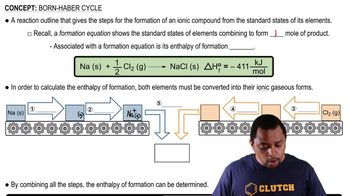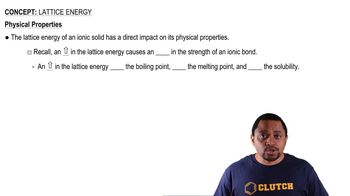Here are the essential concepts you must grasp in order to answer the question correctly.
Born-Haber Cycle
The Born-Haber cycle is a thermodynamic cycle that relates the lattice energy of an ionic compound to its formation enthalpy. It involves several steps, including the sublimation of the solid, ionization of the metal, and the formation of the ionic lattice from gaseous ions. This cycle allows for the calculation of lattice energy by considering the energy changes associated with each step in the formation of the compound.
Recommended video:
Lattice Energy
Lattice energy is the energy released when gaseous ions combine to form an ionic solid. It is a measure of the strength of the ionic bonds in the compound; higher lattice energy indicates stronger interactions between ions. For the formation of NaCl2 to be exothermic, the lattice energy must be sufficiently large to overcome the positive energy contributions from ionization and other processes in the Born-Haber cycle.
Recommended video:
Ionization Energy
Ionization energy is the energy required to remove an electron from an atom or ion in the gas phase. For sodium, the first ionization energy is the energy needed to remove one electron, while the second ionization energy is the energy required to remove a second electron after the first has been removed. In the context of NaCl2, understanding the second ionization energy is crucial, as it directly impacts the energy balance in the Born-Haber cycle and the overall feasibility of forming the compound.
Recommended video:





